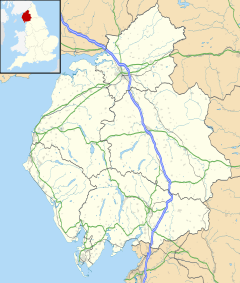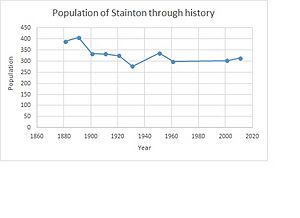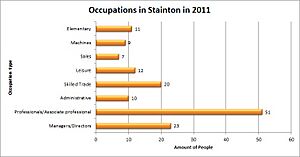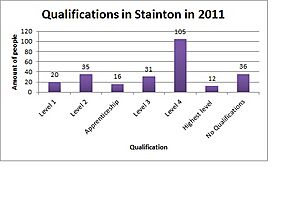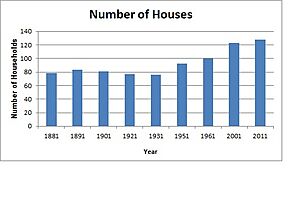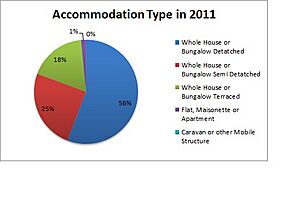Stainton, south Cumbria facts for kids
Quick facts for kids Stainton |
|
|---|---|
 Stainton cross |
|
| Population | 313 (2011 Census) |
| OS grid reference | SD522859 |
| Civil parish |
|
| Unitary authority |
|
| Ceremonial county | |
| Region | |
| Country | England |
| Sovereign state | United Kingdom |
| Post town | KENDAL |
| Postcode district | LA8 |
| Dialling code | 015395 |
| Police | Cumbria |
| Fire | Cumbria |
| Ambulance | North West |
| EU Parliament | North West England |
| UK Parliament |
|
Stainton is a small village and parish in Cumbria, England. It is located in the Westmorland and Furness area. You can find it close to the village of Sedgwick and the town of Kendal. The Killington Reservoir is also nearby, and the village is not far from the A590 road.
In the 1800s, a writer named John Bartholomew described Stainton. He said it was a village in Westmorland, about 4 miles south of Kendal. At that time, the area had 1735 acres and a population of 388 people.
Contents
Exploring the Village of Stainton
Stainton's Past: A Look at History
The name Stainton comes from an old English word. It means "stoney farm" or "stoney settlement." This is because the area used to be a Roman settlement. It is also built on limestone.
Stainton is located southeast of the Lake District National Park. It is about 5.3 miles south of Kendal. The Lancaster Canal also runs close to the village, about 1 kilometer away.
Today, Stainton has a small chapel, a post office, and 128 houses. The chapel was built in 1698. It is no longer used for religious services. In 2003, people started working to turn it into a village hall. Ten years later, in 2013, it became a community center.
Old Buildings and Landmarks
Stainton has many historical landmarks that show its rich past. These include several bridges over Stainton Beck. There is Stainton Bridge, an old packhorse bridge (used for horses carrying goods), and an aqueduct. The aqueduct carries the Lancaster Canal over the beck.
Other important sites are Selet Hall and St Thomas' Church. This church is in the nearby village of Crosscrake. A writer named Wainwright once said that Stainton is "a place of great antiquity." He also wrote about how pleasant the area was. These old buildings help us understand what the parish was like long ago. They also give the village its unique character and charm.
How Stainton's Population Has Changed
This graph shows how many people lived in Stainton between 1881 and 2011. The information comes from census data. There was no census in 1941, so we don't have data for that year.
The population has stayed quite steady over time. There haven't been big ups or downs. In 1881, there were 388 people. The most recent count in 2011 was 313. This steady number might mean that the village's boundaries haven't changed much. It also suggests that not many people moved in or out. A historian named Peter Wood said that in the past, "people rarely moved far away." He noted that families often stayed in the same area for generations. This could explain why the population remained so stable.
Jobs in Stainton: Then and Now
Jobs in 1881
This chart shows the jobs people had in Stainton in 1881. It also separates jobs by gender: males (blue) and females (orange). The data shows that many people worked in farming and with animals. These jobs were mostly done by men. This suggests that farming was hard work. It also shows that Stainton was likely surrounded by countryside. A book about Westmoreland's history confirms this. It says that "a large portion of the township is laid down in meadow and pasture." Peter Wood also mentioned that 100 years ago, farms were often run by families.
The second biggest job area was domestic work, like housework. Most of these jobs were done by women (23 females compared to 2 males). This might mean that Stainton was a traditional village back then. Men worked outside the home, and women managed the household.
Over time, the types of jobs have changed a lot. In 1881, only 4 people were professionals. But in 2011, there were 51 professionals. This change might be because there are more chances for higher-level jobs today. Also, people might need more money now than they did in the past.
Jobs in 2011
In the 2011 census, 226 people in Stainton were aged 16 or older. Out of these, 146 were working. We can compare these numbers to the 1881 jobs. In 1881, farming and domestic work were the most common jobs. Back then, Stainton was probably mostly farmland. There were fewer job choices than in 2011.
In 2011, the largest group of workers were professionals and associate professionals. This is a big change from only 4 in 1881. This shows that over 130 years, jobs have shifted. People now work more in professional roles than in farming. This could be because of better transport to bigger cities. Also, people might want higher wages.
The smallest job groups in 2011 were sales and administrative jobs. These include shop work or office work. This might be because one person in a household earns a good income. So, the other person might choose a more flexible job. These jobs often have hours that fit well with family life.
Education in Stainton
In Stainton, there are 255 people aged 16 and over. The graph shows that 219 of them have qualifications. These range from basic levels to the highest degrees, including apprenticeships. About 105 people in the village have a Level 4 qualification. This is the highest percentage, at 41.2% of the total. This suggests that many residents have good education levels. This can be seen in the 2011 job statistics. Over half (51.8%) of the working people were managers, directors, or professionals.
Out of 255 people, 36 in the parish have no qualifications. This could mean they did not finish school. However, it could also mean they worked on a family farm their whole lives. They might have taken over from earlier generations.
Local Schooling
There is a school at Crosscrake, about one kilometer from Stainton. Some younger residents from Stainton might go to this school. There are 58 people in Stainton under the age of 16. This means they are likely in primary school. A book by Peter Wood says that children from nearby areas go to Crosscrake school. Stainton is probably one of these areas. If young people from Stainton attend this school, it could help them get better jobs in the future.
Homes in Stainton
In 1881, there were 78 households in Stainton. The number of households went down slightly until 1931. After that, the number increased. In 2011, there were 128 households.
The first part of the graph, until 1931, looks similar to the population trend. Both showed a small decrease. This makes sense, as fewer people would mean fewer homes. However, after 1931, households increased while the population stayed steady. This might be because people bought second homes. Or, more single people might have moved into the village.
Types of Homes and Families
These two graphs show how many people live in each home in Stainton. They also show the types of homes in the village. The graph on the left focuses on the number of people per household. It shows that homes with two people are the most common. They make up 46.75% (56 houses) of all homes. This could mean that many homes are lived in by married couples without children. Or, they might be retired couples.
The graph also shows that there are not many large families. Only eight houses have five or more people. This might mean that Stainton does not attract many families with dependent children.
The pie chart on the right shows the types of homes. Most homes are detached houses or bungalows. Semi-detached homes are the next most common. More than half of the homes are detached. This means you are unlikely to see streets lined with many houses close together. These homes might be lived in by small families, married couples, or retired people.
Working Life in Stainton
According to the 2011 census, 226 residents in Stainton are between 16 and 64 years old. Out of these, 146 people are working. This includes part-time, full-time, or self-employed jobs. Only one person out of 226 is unemployed. Seven people are full-time students. This shows that most people in the village are working. It also suggests that few people are receiving unemployment benefits.
A total of 80 people are not working. However, 56 of these are retired. The rest are either students or have a long-term illness. This supports the idea that many people in the village are retirees. They might have chosen to live in Stainton for a peaceful retirement.


